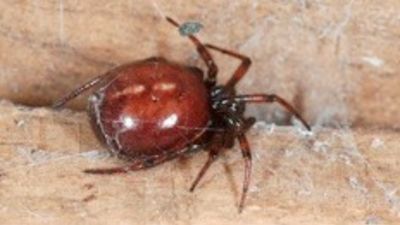How dangerous are false widow spiders?

Sightings of Steatoda nobilis, the false widow spider, are on the rise. It is being cited as Britain's most venomous spider, and it is spreading.
But experts say the species is not usually aggressive towards humans and that being bitten is rare.
What are they?
The false widow spiders (Steatoda) form a group of species that, because of their general resemblance to the much more notorious black widow spiders (Latrodectus), can cause concern when found in Britain.
In fact, these false widow spiders and the true black widow spiders belong to the same family, the Theridiidae.
Six species of false widow spiders are in the UK:
Steatoda grossa
Steatodaalbomaculata
Steatoda bipuctata
Steatoda phalerata
Steatoda triangulosa
Steatoda nobilis
All are black or brown, rotund species up to about the size of a small finger-nail (maximum body length of adult female 15 mm). An additional species, Steatoda paykullianus, is an occasional import in fruit shipments.
Where would you find them in the UK?
Steatoda bipunctata - commonly called the ‘RabbitHutch spider’, is widespread and common throughout the UK. This species is commonly found in and around sheds, pet houses and clutter in gardens and is rather obviously globular and glossy.
Steatoda grossa - is more common in southern England and particularly so towards the SW though a succession of mild winters over the last 15 years or so has allowed this species to increase its range north within the UK and it is now found through the midlands and as far north as Manchester. In colour it is purple-ish brown rather than pitchy black.
Steatoda nobilis - occurs along a stretch of the south coast of England from Dorset to Sussex and more recently Essex; its original range includes Madeira and the Canaries. It has been established near the south coast of England for over a century and is thought to have been repeatedly introduced through ports with imports of bananas.
Steatoda paykullianus– an occasional import with fruit shipments, particularlygrapes, but is not known to have become established in the UK yet. This species is a pitchy black colour often with clear red markings.
Effects of being bitten
If handled unwisely or accidentally, adult female false widow spiders are capable of biting humans but the smaller males are not known to cause bites.
Reports from those bitten by Steatoda grossa and particularly Steatoda nobilis describe a certain amount of pain and often a degree of swelling in the affected part.
These symptoms may last for a couple of days but the total effect is unlikely to be more serious than that.
However, if symptoms were to persist it would be advisable to seek medical attention immediately.
False widow spider facts:
False widow spiders arrived in south-west England in the 1870s.
It is Britain's most venomous spider, although there are no reported deaths from its bite in the UK.
The spider has distinctive cream markings on its body and is brown with reddish-orangey legs.
It eats insects, invertebrates and even other spiders.
It prefers warm, dark places.
The UK has about 650 species of spider and of these only about a dozen are capable of biting humans.